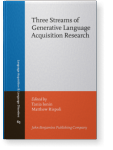Red train, big train, broken train
Semantic aspects of adjectives in child language
This paper investigates the role of formal semantic properties in the acquisition of adjectives. Based on these semantic properties we propose an implicational Semantic Feature Hierarchy, which postulates that the order of emergence is determined by the adjectives’ semantic complexity. To test this hierarchy a high density corpus of spontaneous speech (age 2;00–2;11 years) was analyzed regarding the adjectives’ entailment and gradability properties. The data are in line with our hypothesis that the emergence of adjective classes is based on formal semantic criteria. Moreover, our data analyses show that semantic complexity is not mirrored in type frequency. Regarding the syntactic distribution of adjectives in child language we found that as soon as adjectives and nouns are combined, attributive structures are preferred over predicative structures.
Article outline
- 1.Introduction
- 2.The syntax of adjectives
- 3.The semantics of adjectives
- 3.1Notional properties
- 3.2Entailment properties
- 3.3Gradability properties
- 3.4Semantic complexity
- 4.Previous studies on the acquisition of adjectives
- 4.1Attributive versus predicative adjectives
- 4.2Notional properties
- 4.3Gradability properties
- 5.Hypotheses for acquisition
- 6.Adjectives in German: A case study
- 6.1Data
- 6.2Coding
- 6.3Results
- 6.4Discussion
-
Acknowledgment
-
Notes
-
References
